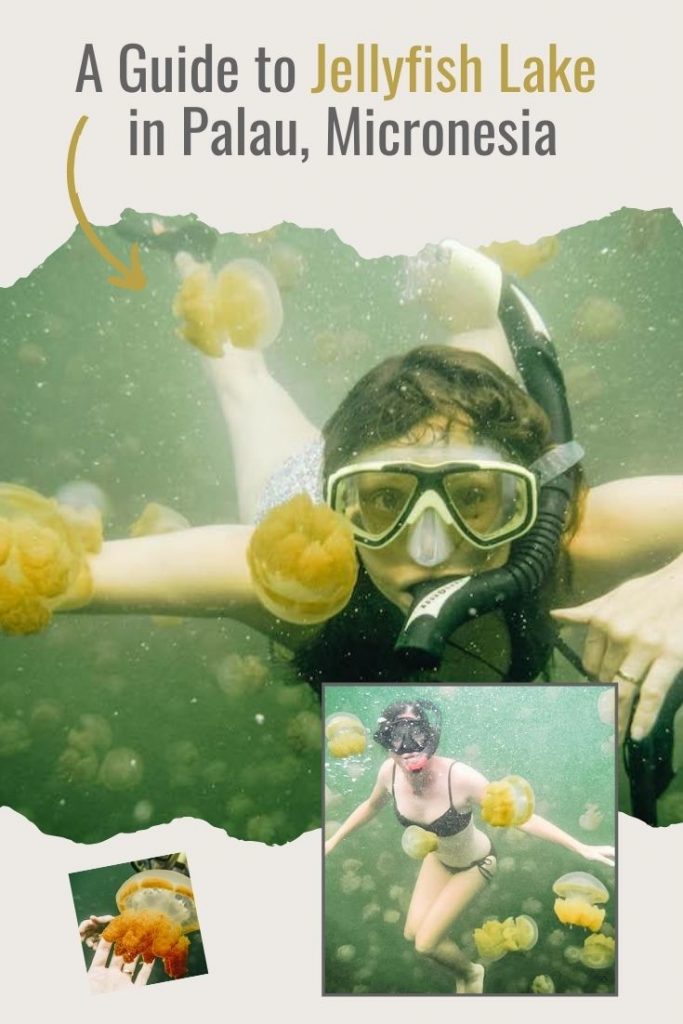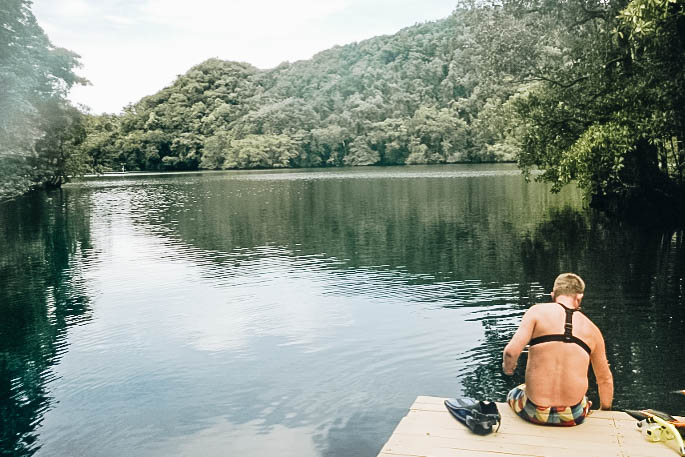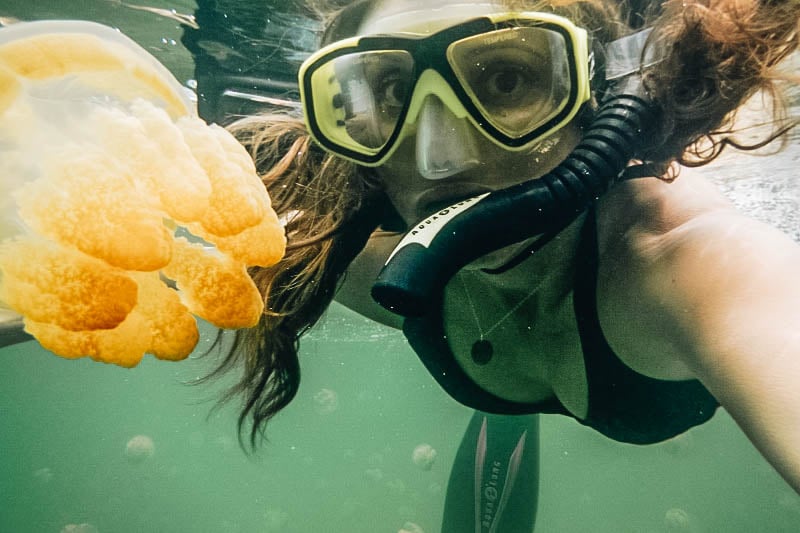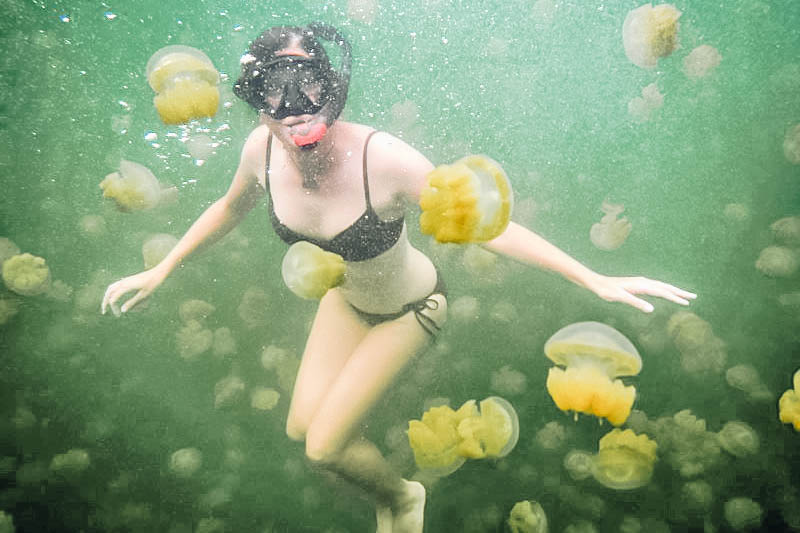When I told my friends about a pending trip to the tiny Micronesian island country of Palau to swim in something called Jellyfish Lake their faces had that half quizzical and half “you’re a crazy lady” look. The rapid-fire of questions followed; Why would you do that? Aren’t you scared? How many jellyfish are there in that lake? Will you wear a wetsuit?
What touched me the most is that the people closest to me actually thought I was courageous enough to jump into a lake surrounded by stinging jellyfish. Not a chance—I love bucket list adventures, but not ones where having to beg strangers to pee on my stinging woulds is a possibility. These freshwater jellyfish are stingless.

A Guide to Swimming in Palau’s Freshwater Jellyfish Lake
About Palau
Palau, a tiny speck of a country that doesn’t even register on Google Maps without having to powerfully zoom—its population is only 21,000. It is certainly a place that very few know much about. A Micronesian country in the western Pacific Ocean (800 miles southwest of Guam), Palau is probably best known for its uninhabited Rock Islands, a group of unique formations created by ancient coral reefs. The limestone islets are topped with jungle-green foliage, while the bases have succumbed to slow erosion creating a distinct mushroom shape, fitting for a scene in Alice in Wonderland.
The surrounding turquoise waters have been called the “underwater Serengeti”, as well as the “seventh underwater wonder of the world”—home to diverse marine life and special hidden treasures. These islands, and their well-deserved inclusion as a UNESCO World Heritage site, are the main reason that many make the long trek here.


About Jellyfish Lake in Palau
Jellyfish Lake is a marine lake situated on the Eil Malk island in Palau. It got its name from the millions of Moon and Golden Jellyfish migrating vertically across the lake. While swimming in the lake you will be surrounded by countless jellyfish as they gently pulsate around you in a hypnotizing dance. Most people would try to avoid this sort of encounter, rubbing themselves in protective creams at the beach and keeping a three-foot radius when seeing one washed up onto the sand. But, at Jellyfish Lake you will be smack dab in the middle of an estimated thirteen million creatures.
The good news is they do not sting! Even the huge ones!
Jellyfish Lake certainly is an anomaly. The fourteen-acre landlocked saltwater lake is home to literally millions of jellyfish that are deemed relatively harmless since they have lost their sting. These Jellyfish evolved without stinging cells because there were no predators in the lake.


Also, it is one of the rare stratified lakes and is only one of 11 local lakes open for the public. The other ones are closed and can be accessed only by scientists. The water in this lake is divided into two layers. The upper layer is oxygenated, and the lower layer does not contain oxygen, which is very dangerous for divers. Jellyfish Lake has these two layers due to specific natural conditions. Firstly, the lake is connected to the ocean by tunnels and fissures in the Miocene reef, which are all close to the surface. Secondly, the lake is surrounded by rock walls and lush trees. They prevent the wind flow and mixing of water does not occur. Thirdly, there’s no drastic change in seasonal temperatures, and the waters of the lake do not mix vertically.
During 2017-2019 the lake was closed for divers because the generation of the Golden Jellyfish was almost gone. But now it has recovered and the visitors are allowed again.


Rules of Jellyfish Lake
When we arrived to the entrance of the lake on Eil Malk Island, the rules that must be abided by were laid out plain and simple:
- Don’t hold the jellyfish.
- Don’t kick the jellyfish.
- Do not remove the jellyfish from the water.
Also, Scuba equipment is banned in the lake not only to protect them, but also because after around 15-meter-depth the lake has lots of hydrogen sulfide which is poisonous and the lower layer of the lake does not contain oxygen.
Note: Get an eco-friendly sunscreen before going there because all the other sunscreens can be confiscated.


My Personal Experience
Passing the entrance booth, we took the fifteen-minute hike up a steep rope-lined trail. It was a heavily forested path with mossy, limestone stairs that needed careful maneuvering. Over the peak and at the bottom of the other side was a small wooden dock that led to the deep turquoise green lake. Standing on this dock preparing my snorkeling equipment, one solo golden jellyfish could be seen in the briny water. Just one. I was worried. This didn’t look anything like the photos on the Internet where countless animals enveloped the adventurous swimmers. It was like Fort Bragg’s Glass Beach in Northern California where the photographs on Pinterest present a shoreline blanketed in saturated colored glass, but in reality it was muted tones, and mixed in with mostly pebbles. It had me briefly questioning whether Photoshop was made for good or evil, and also the technical process for easily multiplying one jellyfish into a thousand.
Just as the guide saw the concerned look on my face, the few visitors were urged to jump into the green lake and swim about a hundred feet out, toward the sunlit waters. Jellyfish didn’t just enjoy basking in the sun; sunlight was critical to their survival, so much so that the agglomeration migrate from the west end of the lake to the east each and every day in search of it. It was a repetitive daily pattern, pumping water through their sepia-toned bells to follow the warm rays shining down from the sky.


Following the instructions, each foot I swam closer toward the light, the jellyfish population grew. It started with that one lonely one by the dock then doubled, tripled, and quadrupled until they completely surrounded me. Then I was worried for an entirely different reason. Contrary to popular belief, these jellyfish were not completely stingless, but instead the sting is so mild that unless you are unusually sensitive it is unnoticeable. Remembering this fact at that moment created a nervous pit in my stomach and the rapid-fire questions swirled through my brain. Are they really harmless? Could it be possible that one hadn’t lost its sting, defying evolution? It would surely find me. Are there medics close by? Unfortunately, there was only one way to find out. The first five minutes in the water were spent panicked any time a jellyfish would brush up against a limb, lightly bumping me like a rubber ducky in the bath. I frantically swam in circles, trying to keep my eye on every one of them, which was impossible since they crowded me in every direction.

Though we were not supposed to touch them, the effort was futile, as their eight broccoli-like tentacles didn’t seem to give them a good sense of direction. One would bonk me in the head, then another in the leg and one more on my back.
After this initial frenzy, a sense of security started to set in and their lackadaisical movements completely mesmerized me. Some were the tiny size of a lime, while others were larger than my head. It seemed like a bizarre underwater dream world where incalculable sepia-tinted parachutes oscillated around me in what seemed like slow motion. It was like a never-ending movie that I could have watched forever.
It wasn’t until my fingers looked like shriveled grapes and my back was certainly the color of a red delicious apple that I exited the lake. Standing back on the dock and looking into the water was bittersweet. During my time in Palau my face had been covered in gray-colored clay, I ogled brilliant red coral on a cliff inside the sea, swam above a slew of sharks, and kayaked into the depths of caves. But nothing quite compared to being given the opportunity to share the water with these spellbinding creatures. I slowly began walking back up the hill, double-checking my body. Nope, not even one tiny little sting.
Unlike popular Asian tourist destinations, Palau is a quiet paradise of transparent sparkling waters, vibrant colorful fish, reefs, jellyfish, rays, and countless species of marine life! Jellyfish lake is a miraculous place where you can swim with thousands of jellyfish! Palau also has the world’s best places for scuba diving. Also, the temperature change is very small, so you can visit this marvelous destination almost all year round!
Essential Tips for Visiting Palau’s Jellyfish Lake
Getting to Jellyfish Lake:
Most excursions to Jellyfish Lake begin from the state of Koror that is serviced by Palau International Airport (ROR). The main gateways to Palau are Guam, Manila (Philippines), Seoul (South Korea), Taipei (Taiwan) and Tokyo (Japan). The remoteness of this region helped nature stay unique and unspoiled. Common flights are on United Airlines (www.united.com) from Honolulu to Guam to Koror or direct from Manila. From the airport, the city center can be reached by car or taxi in about 20 minutes, plus many hotels will offer shuttle service for about $20 USD each way. You should make arrangements with your chosen hotel prior to your arrival. A one way fair for a taxi to Koror is approximately $25. Keep in mind that taxis are not metered, so confirm the cost beforehand.
Language(s): You’re not going to get any language problems since English, along with Palauan, is one of the national languages.
Currency: US Dollar. You will find plenty of ATMs in Koror and major credit cards are accepted at most restaurants, stores and hotels.
Electricity: Plug type A/B plugs, 110v. The outlets are the same as North America, so no adaptor is needed if traveling from the United States.
When to Go: Palau has a yearly average temperature in the mid 80s with high humidity, which makes it pleasant to visit any time of the year. But, being that Palau is in the tropics, rainfall can occur at any time of the year. The best time to go is during the dryer months (November to April or February and March) when there’s a decreased chance of rain. In September, we experienced sporadic rain throughout the day that did not affect any activities and one storm on a snorkeling excursion that created choppy waters that prevented me from jumping in, but not the scuba divers I was with. The water temperature throughout the rock islands is generally between 81-84, perfect bath water.
How to Visit/Planning: Most water-based activities and exploration tours, including Jellyfish Lake, leave from the main city of Koror. For the most part, trips to Jellyfish Lake are not individual excursions; instead they are included in either group dive trips or snorkeling tours of the Rock Islands. With Neco Marine (www.necomarine.com) Jellyfish Lake is included in their all-day Rock island snorkeling tour, which can include such spots as Clam City or Cemetery Reef. Sam’s Tours (www.samstours.com) offers a similar tour with additional snorkeling stops at places like Big Drop off and Milky Way. Fish n’ Fins (www.fishnfins.com) has two tank dives with a stop at the lake, or if you prefer, they also have a snorkeling tour. You can also book this tour that makes stops at Jellyfish Lake, Milky Way, the Beach and Rock Island! Keep in mind that the $100 Koror State Jellyfish Lake permit is typically not included in the quoted price, but should be expected.
Getting Around: Getting around Koror can be done by rental car, taxi or the evening BBI shuttle. Renting a car can be done at the airport terminal, as well as at some of the resorts. Though, navigating your way by car may be tricky, as Koror does not have street signs or traffic signals, plus it’s not really necessary to have a car. Taxis can easily be used when having one arranged beforehand by the concierge or restaurant host. Don’t expect to be able to hail one while just walking along the street. The taxis are not metered; fares are based on your destination. Taxi fares within Koror roughly range from $6-8. In the evenings, you can also take the BBI shuttle that completes a round-trip service in an hour and stops at many of the main locations on the main street of Koror ($7 for a one week pass). Ask your hotel where to get tickets. Most dive centers and hotels offer shuttle service to and from their locations during dive/tour days.
Where to Stay: Most tours begin in the main city of Koror, which makes it the best option choice for your lodging while you are visiting Palau. For the ultimate luxury experience after being in the water all day stay in an oceanfront room or overwater bungalow at the Palau Pacific Resort; from $425), known as Micronesia’s most luxurious resort. Sleep in a villa surrounded by the natural beauty of a tropical paradise at Palau Plantation Resort; from $180). For a more economical, no frills option book a room at The Penthouse; from $76) or DW Motel; from $82).
Where to Eat: For such an unknown place, the country has an eclectic mix of delicious restaurants with heavy Japanese, Korean, Filipino and American influences. Indulge in fresh fish tacos at a favorite in Palau, Kramers Café (1 Pirates Cove, Koror City). Eat with the locals at Emaimelei Restaurant (Lebuu St, Koror) where the kitchen churns out a blend of Filipino, American and local cuisine, at a reasonable price. If you want your Japanese fix, head over to Tori Tori (Derbei, Ikelau Hamlet, Koror) for delicious sushi and sashimi. Elilai is a special treat, situated atop a hillside with lagoon views. Their fresh local ingredients are used to make Pacific Rim cuisine with Japanese, Thai and Italian influences. At Taj you will tempt your senses with the smells and tastes of the spices of India. For the adventurous bucket list eater visit Mog Mog to dine on bowl of the local delicacy, fruit bat soup, where the whole bat (wings, fur and head included) are cooked in a coconut broth. Not for folks who don’t want their food staring them in the face!
Nearby Must-Dos:
- Cover your body in the limestone clay at the bottom on the Milky Way. The creamy mud found on the floor of the inlet is known for its therapeutic properties. Most half and full-day tours of the Rock Islands will make a stop here.
- Head 40 minutes outside of the Koror city center to stand under the 100-foot Ngardmau Falls. If you have a rental car you can navigate your way on your own, otherwise the Palau Big Island Adventure tour
will take you there.- After you have explored the Rock Islands by day, take a night kayak excursion with Rock Island Tours (palauritc.com/english; $55). In the dark you will be able to see the bioluminescent organisms come alive. Their fluorescent glow along with the moon and twinkling stars will light up the calm waters.
Essential Information:
- You will need a Koror State Rock Island permit to scuba dive, kayak, snorkel and swim in Jellyfish Lake. The cost is $100 and is valid for 10 days. Your guide will typically take care of purchasing these permits, but it is not included in the cost of the tour.
- There is a $50 per person departure tax and green fee that can be paid in cash directly at the airport upon departure. A visa is not required for United States visitors staying for less than 365 days, though you must have a valid passport with at least one blank page.
- Protecting Jellyfish Lake is incredibly important, so be respectful while you are there; do not lift the jellyfish out of the water, enter the lake clean and free of sunscreen, do not use the lake as a restroom and wear fins to slow your movements. Follow the rules of the lake in order to ensure that the jellyfish will be there for a long time to come.
- Scuba diving is not allowed in the lake because the bubbles can be trapped in the jellyfish’s bell.
Packing Tips:
- Palau is very casual, with a relaxed island style; shorts, tanks and tees prevail. Leave your stilettos and sparkly dresses at home.
- Don’t come to Jellyfish Lake (or Palau for that matter) without an underwater camera, you’ll be disappointed at not being able to capture the underwater treasures. If your camera has video capabilities that’s even better as the mesmerizing pulsating moves of the jellyfish are fascinating.
- Pack a rash guard as an extra protection from the hot sun.
- A small dry daypack is helpful not only for the hike to Jellyfish Lake, but also the boat rides through the Rock Islands
- Bring along comfortable walking/water shoes that have some traction, it can get slippery on the trail.
- Pack light snacks for the tours. Even though lunch is typically included a granola bar or trail mix can ease some hunger.
Palau takes their eco-protection very seriously and the government is diligent about protecting their pristine nature. It leaves an unforgettable experience of the place where nature and human are living peacefully together. When you come to Palau you have to sing and read the pledge:
“Children of Palau, I take this pledge, as your guest,
to preserve and protect your beautiful and unique island home.
I vow to tread lightly, act kindly, and explore mindfully.
I shall not take what is not given. I shall not harm what does not harm me.
The only footprints I shall leave are those that will wash away”This post may contain affiliate links. If you make a purchase through my links, I earn a commission that helps to keep this blog running—at no extra cost to you. For more information read my full disclosure.
More About Palau
Palau Bucket List: 25 Things to do on the Micronesian Island
Get a Natural Mud Bath in Palau’s Milky Way
Top 100 Things to Do Before you Die
Micronesia & Palau Travel Guide

I am so jealous, I first learned about Palau soon after I started my list, and this has been on it ever since! Your pictures look greener than the ones I’ve seen, I imagined it very blue and tropical, like Caribbean or Indian oceanic waters.
It’s still so beautiful though, and this really is worthy of that spot in the list!
It is definitely a little paler green, but not blue like the Caribbean. I can’t recommend enough taking a swim in Jellyfish Lake. It is completely wild! With as much adventure as you pack into your life, I am sure you will end up there soon :)
i loved that you did this!! i have this on my bucket list too.. but marine life weirds me out. haha but i might actually be less scared of these than a school of fish. i’ll let you know when we go there!
Schools of fish are fine for me, unless they are a school of sharks!
If the pee-on-a-jellyfish comment is a reference to “friends”, then you just got even cooler :p
…consider me cooler ;)
Amazing! So did it really not hurt at all when they brushed up against you? I’ve always wondered how people were able to swim in there.
The Jellyfish did not hurt at all!
Unreal! I never would have imagined a whole lake packed with stinging yet harmless jelly fish. Were the light stings massaging or ticklish like at the fish spa?
The jellyfish weren’t actually massaging or ticklish. I couldn’t feel a thing even when I touched one with my hand.
This is so cool! I’d love to go swimming here, even though I’m sure I’d be nervous for the first few moments — just like you, I’d be wondering if there was just one that could sting me! So pretty!
It was totally worth the first 5 scary minutes!
SO cool! Makes me wish I was a stronger swimmer…
Surprisingly, we all floated pretty well!
This is pretty incredible! I lived in Australia for 6 months and it was the complete opposite of this.
There’s a joke that everything in Australia can kill you, and the jellyfish are no exception! You can’t swim in the ocean in many parts of the country simply because of the danger of the jellyfish. These little guys you swam with on the other hand seem awesome. Would definitely like to do this one day. Thanks for sharing!
Remind me not to go swimming in Australia!
Wow! So beautiful underwater scenes Annette. After seeing this amazing and adventurous trip you had I hate my self. I don’t know this water scares when I try to go for Swimming. :(
Awesome post, this has been on my bucket list for a long time now. It’s time to make it happen.
I hope you are able to check it off your list soon, because it is incredible!
Oh my! This is so amazing! I would like to do this too!
After this post I will definetly visit your site again!
Btw, I would have been afraid, that some of those creaures can harm me, just like you ;)
I think most people I was with were a little bit scared in the beginning. How could you not be?!?
Awesome post!! Loved the pix and details. I enjoyed reading your post and I think others will too so that’s why I used one of ur pic on my blog, List of Living (http://wp.me/p4fLip-3P). I ensure that proper credit was given but if you would like me to remove the content, I totally understand. Again, thanks for the awesome post and keep being an inspiration!
Thanks for the mention on your blog. I’m looking forward to your future posts :)
Have you tried swimming with piranhas or with barracudas? :P
Not a chance ;)
Such great memories! And without a doubt one of the TOP travel experiences to date. Love the photo of me sitting on the dock getting my GoPro sorted. Looks like I’m wearing a bra or something!
I just loved it. amazing!
They don’t sting because they have adapted for so long in there and they have no natural enemies. I would still be afraid though, at first. Jellyfish are probably my favourite sea creatures, next to whales, but am absolutely terrified of them as it should be. They are a little tricky to imagine because I can not see them, so I think this would be the perfect experience for me to check them out in a totally safe way. Maybe one day.
I suppose it would be sort of similar to me swimming under water in a pitch black sea and that would terrify me if I couldn’t see what was within a few feet of me. If something brushed up against my leg I’d freak out!
I love this story! You have inspired me to someday complete this jelly fish encounter on my own personal bucket list. I only recently found your website but I love reading about your experiences and you’ve actually inspired me to add a few to my list. (I hope that’s okay)
I’ve always had an adventurous mindset and I love writing so I thought why not start my own and combine the two aspects? I’m only in the beginning stages of my website and in my bucket list in general. I have not set foot out of the country yet but I daydream about it daily. I have however partaken in adrenaline junkie activities and other items on my bucket list.
Thank you for the inspiration and I hope one day my husband and I have our own versions of some of the stories you have!
Hello Sami! I checked out your blog and it looks like you have a GREAT start to your bucket list. In the beginning of mine, I didn’t travel so much, but still managed to check off quite a few things close to home. I wish you the best of luck in having the most memorable experiences life has to offer :)
Thank you for the response! I really appreciate the fact that you checked mine out! It will continue to grow until I’m totally happy with it :) But if you have any suggestions and such, I would appreciate it any time! That’s exactly what I’m doing right now: checking off local items and I think I’m doing okay for only recently starting it. The travel will come with time I’m sure :) I subscribed to yours today so I really look forward to reading more of your adventures in the future! Again thank you for the feedback! :)
Looks amazing! I am obsessed with jellyfish. I am planning to travel there for the jellyfish but am not sure what time of year is best to go see them. I don’t wanna plan a trip then arrive at the lake and there be no jellyfish! What is/are the best month/months to go? Help me out please!
Hello Evelyn,
This was one of my favorite bucket list experiences of all time. I went in the month of September and they were plentiful. Here’s what thecircumference.org has to say about the season: “Although snorkeling Jellyfish Lake can be done year round, the best time of year for Palau diving is considered to be November through May, due to a decreased chance of rain. A few years ago, all the jellyfish in the lake were killed by extreme and sustained hot weather. Luckily the eggs survived, and the next year the jellyfish were back in even greater numbers. If you’re flying all the way to Palau for this particular experience, it might be worth emailing Fish n’ Fins ahead of time to check in on the status.”
Ahhhhh thank you so much for the help!
I just heard recently about the dangers in the lake for the jellyfish. This was new to me. Is there any danger?
It is probably best to speak to your licensed guide, but when I was there, there were absolutely no problems. Myself and about a dozen others bumped into plenty of Jellyfish without a dangerous incident.
Cool photos. I didn’t know somewhere like this existed but as long as they don’t sting I think that would be brilliant.
Yes, that was my criteria for swimming there too :)
OHhhhh myyyyy. I am so absolutely jealous! I saw Brian Cox swim with these Jellyfish on TV and ever since I’ve been obsessed. I only wish it wasn’t so expensive to fly to. :(
To date, this is still one of my most favorite experiences!
This place is truely magical. Have been there last year and it was a wonderful experience. At first when we arrived in Palau, we had some issues to reach our hotel becuase we arrived at night. But after a few days everything was fine and we had the best vacation ever in palau.
First off, the photos look astoundingly surreal and out of this world! It’s like the sceneries were only captured to be viewed on a movie screen! The beautiful art of nature plus great photography equals these masterpieces! Thank you for sharing this beautiful place with us even though it’s only through virtual but you made us inspired and motivated to work our asses off to even just visit this place!
I am so jealous, I first learned about Palau soon after I started my list, and this has been on it ever since! Your pictures look greener than the ones I’ve seen, I imagined it very blue and tropical, like Caribbean or Indian oceanic waters.
Unreal! I never would have imagined a whole lake packed with stinging yet harmless jelly fish. Were the light stings massaging or ticklish like at the fish spa?
WOw, beautiful scene! Does the jellyfish stings? I hope not. I would love to see it with my own eyes too. Thanks for sharing your experience.